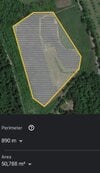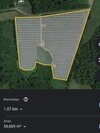Yeah, 10,000 was based purely on area at 20% efficiency and 1kw/m^2 .
For ground mount arrays if you used 100kW per acre including provisions for utilities, access, security, shade effects, maintenance access, etc that seems about right for smaller arrays. Clearly roof mount is denser, but that isn't going to be sufficient for most fleets.
A Megapack has about 3,800 kWh, approx.
For Semis I'm expecting about one Megapack per every ten or so Semis, and the maths tend to support that. That way an unreinforced 'thin' pipe (electrical supply) can trickle in enough energy during the time when the Semi is out on the road; store that energy in the Megapack; and then discharge it fairly promptly into the Semi(s).
If the Semi has 900-1000 kWh pack (we are still unsure) but in practice uses (say) 300kWh for an average daily drive (the current opinon being 850kWh for 500-miles), then in principle from an energy (kWh) perspective the ratio is approx 10:1 assuming you cycle the Megapack daily from 10-90% SoC. The Megapack seems to have a 1.5MW inverter so that - ignoring tapering - it could dump out 3MW in 2-hours (ie. ten Semis). Allowing for tapering that would be very reasonable for a 8-hour Semi charge cycle overnight. In fact you could probably do a lot better than that and get two shift use of the Semi if you tried a bit harder.
To recharge 3MW (3,000 kWh) over 24-hour period (note, it doesn't have to stop drawing from grid during the 8-hour Semi charge period) you need to be able to import electricity to site at 125 kW (ignoring loss terms for simplicity). A 240V x 100A x 1ph supply is 24kW so that won't cut it for a 10 Semi fleet (but would for a single Semi loner, with a Powerpack sized storage solution). A 440V x 100A x 3ph supply will do 76kW so is only halfway there. Implication is that a 10-Semi fleet needs one Megapack and a 200A 440V 3ph electrical supply to get a matched solution. That is quite a reasonable feed to get at 415V/440V. If one wants more than that the distribution network operator (aka electrical 'utility') will likely be looking at an 11kV feed to site.
Clearly it will be very attractive to self-generate solar. Global average solar capacity factors are now 14%, trending upwards about 1% every 4 years. Using 14% we get that 100kW (i.e. one acre ground mount) would deliver 100 x 24 x 365 x 0.14 = 122,640 kWh, i.e. an average of 336 kWh per day. So a 10-acre solar array would be a fair match for a ten Semi fleet, with one 3,800 kWh Megapack.
This handily is an acre of solar per Semi.
Done like that the electrical supply capability can be somewhat reduced depending on the seasonal and daily variation in the solar resource. But for most northern cities (i.e. where most relatively affluent humans live) the daylight hours reduce to approx 6h only* at the Winter solstice, and that is before taking into account poor winter weather. The 6h is for 44N, i.e. Bordeaux or Boston. However at (say) 32N San Diego has a minimum winter day of 11h, much more helpful, so expect to see adoption work from the US southern states northwards.
It is very difficult to run a private wire network across public or third party land. That is so in almost all of the world, and I don't expect that to change much. So the solar array needs in practice to be contiguous with the overnight charging depot. Expect to see a lot of 10-Semi 10-acre 1-Megapack clusters around the edges of townships fringeing big cities, as they can get going faster than big grid reinforcement can be brought in to the 100-rig fleet depots.
A 10-acre site is going to struggle to get a meaningful wind turbine. Get to a 100-acre site and you can reasonably start to get a cluster of MW-class wind turbines. (Please spare me the distributed wind hopium as that is only applicable ib fairly exceptional use cases).
A lot of farms have a 100A 415V 3ph supply. So if they put 10-acres to solar they could reasonably run a 10-rig fleet right through the middle of winter, i.e. in mid-winter half the energy is coming from the grid and half from self-generation.
Go buy your edge of town farm in the commuter belt, and start trucking !




